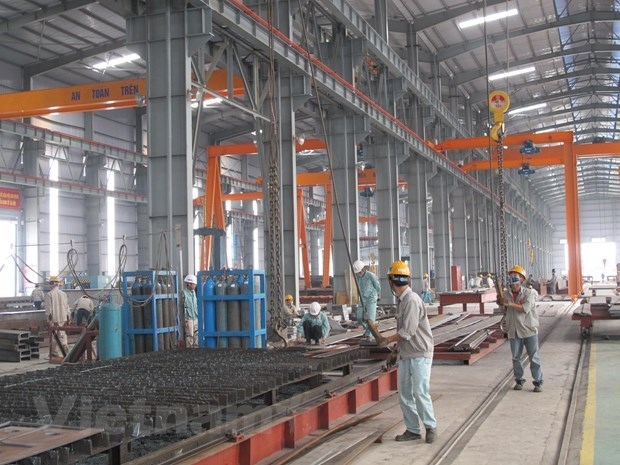Vietnam can emerge as perfect example for post-COVID economic growth: expert
VOV.VN - News outlet moderndiplomacy.eu has recently published an article outlining the nation’s economic momentum as it moves past the novel coronavirus (COVID-19), describing the country as a perfect example for the global south.
According to the article, IMF reports stated the Vietnamese economy was anticipated to grow at a rate of 2.7% this year, largely because it is showing signs of a strong recovery in the post-pandemic phase. Prime Minister Nguyen Xuan Phuc stated that the local economy will grow at a rate of up to 5% this year, exceeding predictions made by the IMF back in April. This would mean that the acceleration witnessed in the economy after successfully defeating the COVID-19 virus puts the country on course to recover much faster than many other Asian economies in the region.
Author of the article Prof. Pankaj Jha said, in the revised IMF estimates released in May the Vietnamese economy is expected to grow at 7% next year, although given the encouraging signs relating to economic momentum, it may go on to surpass this level of projected economic growth. Slow demand from both Europe and the United States has had a negative impact on Vietnamese exports, adversely affecting projected growth of 6.8% for the year, with even 5% growth being considered laudable. In terms of the resurgence in manufacturing, in addition to the possible alternative to Chinese exports in a few niche markets, the nation may reap the benefits of an early recovery. Along with economic growth, rising inflation has also occurred and is likely to reach over 4% this year.
The second quarter has witnessed a number of promising economic development indicators, with Bloomberg reporting that the country posted a trade surplus of US$500 million in June, while it suffered a trade deficit of US$900 million in May. The US market has also been showing signs of recovery, with US-Vietnam trade expected to reach US$80 billion over the coming years due to a bilateral trade agreement signed between both sides in 2000.
Furthermore, the impending FTA between Vietnam and EU has served to facilitate better trade avenues for the nation. Indeed, the trade agreement will facilitate tariff free entry for more than 71% of Vietnamese goods to Europe, while over 65% of European goods will enjoy tariff free entry into the domestic market.
Despite many market analysts predicting that the US may move to shift its supply chain, which has become overly dependent on China, to other countries, it is possible the nation may not immediately benefit from such a shift. Although a few multinational corporations may shift their base to the country or other Southeast Asian neighbours due to cheap labour costs, this process will only take place over the long term.
Recent years has seen the nation enjoy a rise in foreign direct investment from European and US companies, largely due to an improvement in legal aspects and an overall better business facilitation environment. Indeed, US President Donald Trump has indicated that many countries in Asia which have huge economic potential are lagging behind in benefiting from globalisation, liberal trade values, and effective financial architecture. In light of these aspects, political forces have been making tectonic changes in terms of the global economic landscape.
Trade relations between the US and Vietnam saw the trade deficit between the two countries reach US$40 billion last year, with the country having a positive trade surplus, and the issue being raised by concerned US authorities. As a means of capturing the US market, the nation must move to increase its level of trade and also start importing products from the North American country such as automobiles, bikes, and other consumer products. This would mean that the both sides can work together to bring about balance in trade while simultaneously expanding the commodities basket.
There are a number of positives which have emerged as the country moves past the COVID-19. This includes the active intervention of the political establishment in an effort to address inherent lacunae and anomalies within the Vietnamese economy. Moreover, efforts have been made to rationalise the local tax structure, improve infrastructure, address business challenges, initiate public sector reforms, and enforce better banking standards. The weak banking system and financial architecture have therefore impacted the overall growth of the local economy. Also, the Vietnamese currency has kept within a certain range in an effort to bring about more foreign exchange and avoid currency fluctuations in the international market.
The relatively low labour costs seen in the country, coupled with the growth of small and medium enterprises (SMEs), could be beneficial for foreign direct investors as they strive to create an economic ecosystem which is capable of providing employment to many, with the nation already enjoying one of the lowest unemployment rates in Asia. Indeed, last year saw the unemployment rate stand at 2.2% of the total working population. Furthermore, the country is a highly literate nation that is striving to develop a new education system that is capable of providing skilled workers and language experts to lure foreign firms to invest locally. Better vocational training institutes, effective industry-specific skill training centres, and improvements in higher education are the prime focus of the Vietnamese political establishment who seek to bring about necessary changes required for promoting foreign direct investment into the country. One of the nation’s biggest achievements in the past decade has been the perceptible decline in corruption.
At present, the domestic economy primarily consists of SMEs in fields such as textiles, metal forging, plastics, paper, tourism, agriculture, and telecommunications. However, a number of services within the local economy have potential, including education, medicine, tourism ,and telecommunications. As such, the country has been making significant inroads into sector such as automobiles, electronic, and software technologies.
Most notably, Vietnamese Prime Minister Nguyen Xuan Phuc recently approved a US$9.3 billion tourism project initiated by Vingroup. This can be considered one of the largest investments made by the largest Vietnamese private conglomerate of Vietnam, with the project set to be located south of Ho Chi Minh City and will be completed by 2031.
Moreover, the Vietnamese political establishment is also making every effort to bring in greater levels of foreign direct investment from Asian and European countries as a means of boosting its manufacturing whilst also developing its industries in high-technology sectors.
Prof. Pankaj Jha emphasised that the country may enjoy the benefits of post-COVID-19 economic growth due to the swiftness of structural reforms and trade facilitating measures, with the nation expected to emerge as a perfect example for the global south to follow.



